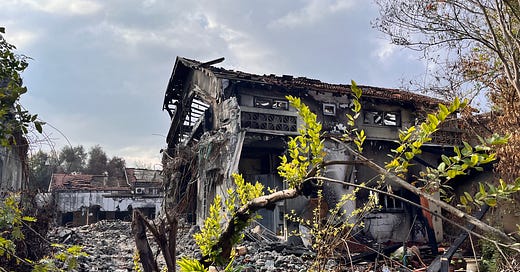Over the period 11-19 December 2023, I visited Israel with colleagues from the Center for Strategic and International Studies (CSIS) in Washington DC. For full transparency, I paid for all my transport to and from Israel; CSIS paid for meals and accommodation in Israel. The IDF or Government of Israel did not pay for our visit, although they did facilitate many of our visits given that many areas we travelled to are now considered active combat zones and inaccessible to civilians. I deeply appreciate this support provided by the IDF.
Visit Program
Over the week, we were able to speak to a wide range of serving and retired senior military, intelligence and government officials, journalists, think tank personnel and Israeli citizens. Discussions were conducted on background, and as such, I do not identify individuals in my observations that follow.
During our visit, we undertook meetings in Tel Aviv (including at the IDF GHQ) and Jerusalem (including at the IDF Central Command), and conducted field visits to the following locations:
Kibbutz Be’eri in southern Israel.
Kibbutz Nir Oz in southern Israel.
Palmachim Air Force base (south of Tel Aviv) for a briefing on Iron Dome.
Along the northern border with Lebanon.
Kibbutz Eilon in northern Israel.
The Golan Heights.
There are a variety of themes that emerged from the visit.
But before I describe these, it is worth describing the environment in Israel at present. Every interlocutor demonstrated some form of trauma because of 7 October and the following weeks. This manifested in a variety of ways, physically and emotionally. The most commonly evident manifestation was a mix of shame, shock, and rage at what had occurred, the political situation beforehand that many believed set the scene for the 7 October, and the events in Gaza since.
As several of our interlocutors described, “Israel is a sad country at the moment”.
It is also worth noting up front two other issues. First, we were unable to visit Gaza and did not hold discussions with Palestinians. This is important to understand because it means we were exposed to one side of the story. That said, the Israeli story is very important to understand. Second, the observations here are mine, and mine alone. I expect there will be aspects where I lack context or background on certain issues.
I have split the remainder of my observations into three temporal elements: before 7 October; the day of 7 October; and events since the 7 October Hamas massacre. I will publish each as a separate article here, with Part 1: Observations on the Lead Up to 7 October, included in this post.
I have also included several recommendations at the conclusion of my observations, and these appear in Part 3 of the observations from my visit.
Keep reading with a 7-day free trial
Subscribe to Futura Doctrina to keep reading this post and get 7 days of free access to the full post archives.




